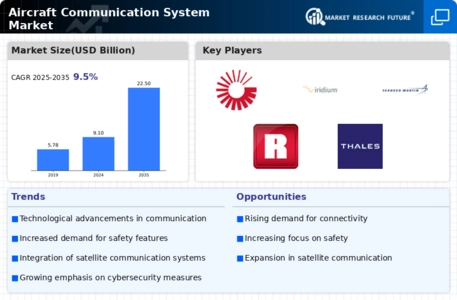Market Analysis
In-depth Analysis of Aircraft Communication System Market Industry Landscape
The market dynamics of the aircraft communication system sector depict a dynamic and evolving landscape driven by factors such as technological advancements, regulatory requirements, market competition, and industry trends. Aircraft communication systems play a critical role in enabling seamless and reliable communication between aircraft and ground stations, air traffic control, and other aircraft in flight. As the aviation industry continues to grow and modernize, the demand for advanced communication systems that offer increased bandwidth, data transfer rates, and connectivity options continues to rise.
Technological advancements drive innovation and competitiveness in the aircraft communication system market. Manufacturers invest heavily in research and development to develop next-generation communication technologies that address the increasing demands of modern aircraft operations. Advancements in satellite communication, wireless networking, and digital data link technologies enable faster and more efficient data transmission, voice communication, and cockpit connectivity. Moreover, integration of internet protocol (IP) based communication systems and software-defined radios (SDR) enhances flexibility, interoperability, and scalability in aircraft communication systems, enabling seamless integration with existing avionics and ground-based networks.
Regulatory requirements and certification standards play a crucial role in shaping the dynamics of the aircraft communication system market. Aviation regulatory bodies such as the Federal Aviation Administration (FAA) and the European Aviation Safety Agency (EASA) establish airworthiness standards and certification requirements for aircraft communication systems to ensure compliance with safety, reliability, and performance criteria. Manufacturers must undergo rigorous testing, validation, and certification processes to demonstrate the safety and effectiveness of their communication systems before they can be installed on certified aircraft. Compliance with regulatory requirements is essential for gaining market acceptance and securing contracts with aircraft manufacturers and operators.
Market competition drives innovation, pricing, and market positioning in the aircraft communication system market. Manufacturers compete for market share by offering a wide range of communication system products and solutions tailored to different aircraft types, mission requirements, and operational needs. Competitive pricing, product reliability, customer support, and aftermarket services are key factors influencing purchasing decisions among aircraft operators and manufacturers. Moreover, strategic partnerships, mergers, and acquisitions enable companies to expand their product portfolios, access new markets, and strengthen their competitive position in the global aviation industry.
Industry trends such as digitalization, connectivity, and autonomous aviation influence the demand for aircraft communication systems. As aircraft become more connected and reliant on data exchange for operations, there is a growing need for robust and secure communication systems that can support increased data traffic, real-time information sharing, and remote monitoring capabilities. Moreover, advancements in autonomous aviation technologies such as unmanned aerial vehicles (UAVs) and urban air mobility (UAM) platforms drive innovation in communication systems to support autonomous navigation, collision avoidance, and remote piloting capabilities. Aircraft communication system manufacturers must stay abreast of industry trends and emerging technologies to capitalize on market opportunities and meet the evolving needs of aviation customers.









Leave a Comment